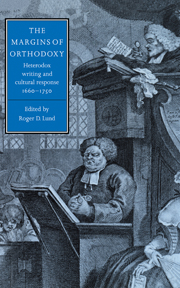21 results
4 - Religious Thought: The Defence of Religious Establishment
-
-
- Book:
- The Cambridge Companion to Eighteenth-Century Thought
- Published online:
- 15 June 2021
- Print publication:
- 20 May 2021, pp 131-161
-
- Chapter
- Export citation
PART I - THE IDEOLOGY AND ORIGINS OF HETERODOXY
-
- Book:
- The Margins of Orthodoxy
- Published online:
- 09 October 2009
- Print publication:
- 23 November 1995, pp 31-32
-
- Chapter
- Export citation
PART III - POLICING THE MARGINS
-
- Book:
- The Margins of Orthodoxy
- Published online:
- 09 October 2009
- Print publication:
- 23 November 1995, pp 117-118
-
- Chapter
- Export citation
PART II - LOCKE AND HETERODOX OPINION
-
- Book:
- The Margins of Orthodoxy
- Published online:
- 09 October 2009
- Print publication:
- 23 November 1995, pp 71-72
-
- Chapter
- Export citation
Introduction
-
-
- Book:
- The Margins of Orthodoxy
- Published online:
- 09 October 2009
- Print publication:
- 23 November 1995, pp 1-30
-
- Chapter
- Export citation
Contents
-
- Book:
- The Margins of Orthodoxy
- Published online:
- 09 October 2009
- Print publication:
- 23 November 1995, pp ix-x
-
- Chapter
- Export citation
PART IV - ORTHODOX DEFENSES, HETERODOX RESULTS
-
- Book:
- The Margins of Orthodoxy
- Published online:
- 09 October 2009
- Print publication:
- 23 November 1995, pp 217-218
-
- Chapter
- Export citation
List of contributors
-
- Book:
- The Margins of Orthodoxy
- Published online:
- 09 October 2009
- Print publication:
- 23 November 1995, pp xi-xii
-
- Chapter
- Export citation
Select bibliography
-
- Book:
- The Margins of Orthodoxy
- Published online:
- 09 October 2009
- Print publication:
- 23 November 1995, pp 271-292
-
- Chapter
- Export citation
Acknowledgments
-
- Book:
- The Margins of Orthodoxy
- Published online:
- 09 October 2009
- Print publication:
- 23 November 1995, pp xiii-xiv
-
- Chapter
- Export citation

The Margins of Orthodoxy
- Heterodox Writing and Cultural Response, 1660–1750
-
- Published online:
- 09 October 2009
- Print publication:
- 23 November 1995
Frontmatter
-
- Book:
- The Margins of Orthodoxy
- Published online:
- 09 October 2009
- Print publication:
- 23 November 1995, pp i-viii
-
- Chapter
- Export citation
7 - Irony as subversion: Thomas Woolston and the crime of wit
-
-
- Book:
- The Margins of Orthodoxy
- Published online:
- 09 October 2009
- Print publication:
- 23 November 1995, pp 170-194
-
- Chapter
- Export citation
Index
-
- Book:
- The Margins of Orthodoxy
- Published online:
- 09 October 2009
- Print publication:
- 23 November 1995, pp 293-298
-
- Chapter
- Export citation
J. A. Downie. To Settle the Succession of the State: Literature and Politics, 1678–1750. New York: St. Martin's Press. 1994. Pp. xii, 170. $45.00. ISBN 0-312-12117-2. - Ian Higgins. Swift's Politics: A Study in Disaffection. New York: Cambridge University Press. 1994. Pp. xiii, 232. $54.95. ISBN 0-521-41814-3.
-
- Article
- Export citation
Motor, Volitional and Behavioural Disorders in Schizophrenia: 1: Assessment Using the Modified Rogers Scale
-
- Journal:
- The British Journal of Psychiatry / Volume 158 / Issue 3 / March 1991
- Published online by Cambridge University Press:
- 02 January 2018, pp. 323-327
- Print publication:
- March 1991
-
- Article
- Export citation



